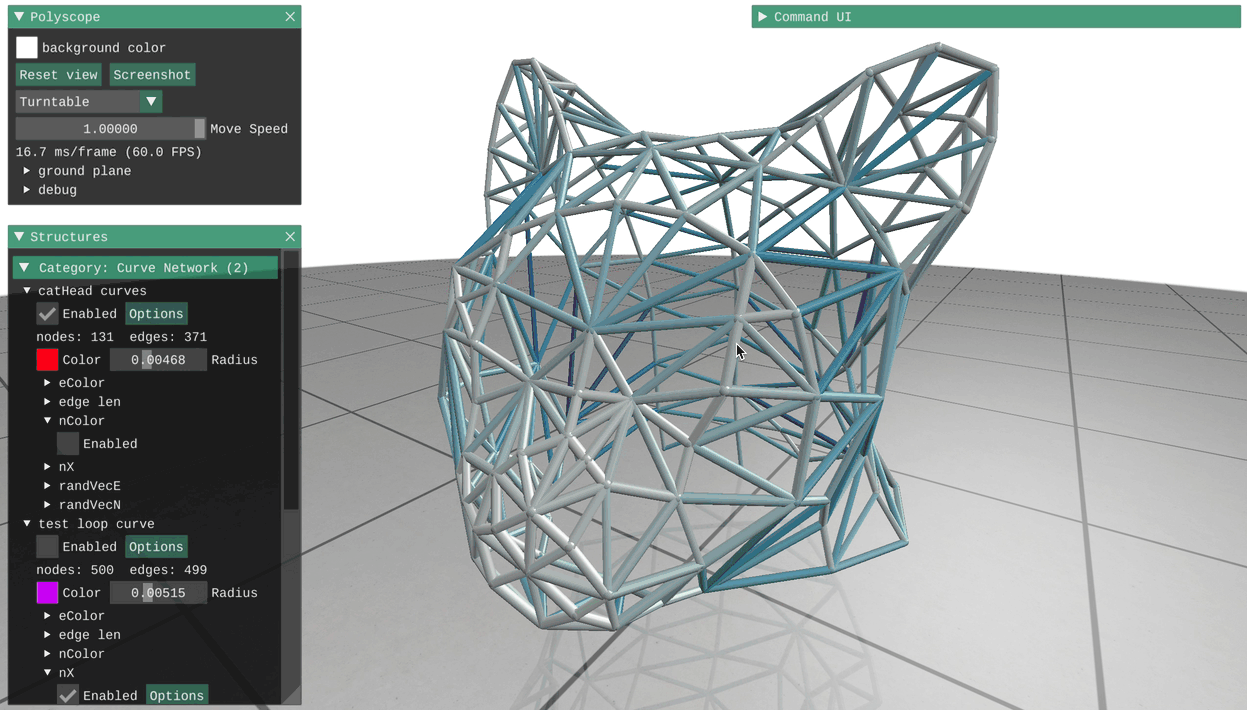Curve Networks¶
Curve networks are collections of nodes sitting in space, connected by edges. In addition to displaying the nodes and edges of the network itself, Polyscope can show any number of scalar, vector, or color quantities associated with the nodes or edges of the network.
Try clicking on a node or edge to see the data associated with that point!

Registering a curve network¶
Curve network structures can be registered with Polyscope by passing the node position and edge indices.
Example: a network of random curves
import numpy as np
import polyscope as ps
ps.init()
# generate some random nodes and edges between them
nodes = np.random.rand(100, 3)
edges = np.random.randint(0, 100, size=(250,2))
# visualize!
ps_net = ps.register_curve_network("my network", nodes, edges)
ps.show()
Convenience adders for common cases
Rather than passing a vector of edge indices, there are also built-in helpers for common cases of connectivity, like a single continuous sequential line or loop, or a collection of line segments. To use them, pass the string line, loop, or segments in places of edge indices, like register_curve_network("name", nodes, edges='segments').
edges='line'The nodes will be connected together sequentially, forming a single curveedges='loop'The nodes will be connected together sequentially, including the last to the first, to form a closed loopedges='segments'The2Nnodes will be connected to form a set ofNline segments, interleaved as in[start_0 end_0 start_1 end_1 ...]
register_curve_network(name, nodes, edges, enabled=None, radius=None, color=None, material=None)
Add a new curve network structure to Polyscope.
namestring, a name for the structurenodes, anNx3numpy float array of node locations (orNx2for 2D)edges, anEx2numpy integer array of edge connections, as 0-based indices in to the nodes array, OR the stringline/loop/’segments’, to generate node connectivity as a line or loop, respectively.
Additional optional keyword arguments:
enabledboolean, is the structure enabled initiallyradiusfloat, a size for the nodes and edges relative to the scene length scale (useset_radius(val, relative=False)for absolute units)colorfloat 3-tuple, default color values for the network as rgb in [0,1]materialstring, name of material to use for network
if not specified, these optional parameters will assume a reasonable default value, or a persistent value if previously set.
2D node positions are also supported, see 2D data.
Updating a curve network¶
The locations of the nodes in a curve network can be updated with the member function update_node_positions(newPositions). All quantities will be preserved. Changing the connectivity or number of nodes/edges is not supported, you will need to register a new curve network (perhaps with the same name to overwrite).
CurveNetwork.update_node_positions(newPos)
Update the node positions in a curve network structure. newPos must be valid input as to initially construct the nodes of the network, with the same number of nodes as the network curently has.
Adjusting the node and edge radius¶
Set the radius of the nodes and edges in the curve network with CurveNetwork.set_radius(newRad), or in the constructor. By default, the radius is a relative value which gets scaled by the content in the scene, so for example a default of 0.02 will always be a reasonable size no matter what the scale of the content in your scene is. Or, set relative=False to set an absolute radius in world units.
CurveNetwork.set_radius(newVal, relative=True)
Update the radius for the nodes and edges in the curve network.
By default the radius is interpreted as a relative value, setting relative=False will treat is as an absolute length in world units.
To set a variable radius which is different for each node and/or edge in the curve network, see the variable radius page.
Options¶
Options control the appearance of the curve network. These options can also be passed as keyword arguments to the initial register_curve_network(), as noted above. See structure management for options common to all structures such as enabling/disabling, transforms, and transparency.
| Parameter | Meaning | Getter | Setter | Persistent? |
|---|---|---|---|---|
| radius | size of rendered nodes/edges | get_radius() |
set_radius(newVal, relative=True) |
yes |
| color | default color for the network | get_color() |
set_color(newVal) |
yes |
| material | material for structure | get_material() |
set_material(newVal) |
yes |
Example: set options which affect the appearance of the curve network
network = polyscope.register_curve_network("my net", nodes, edges)
network.set_enabled(False) # disable
network.set_enabled() # default is true
network.set_radius(0.02) # radius is relative to a scene length scale by default
network.set_radius(1.7, relative=False) # radius in absolute world units
network.set_color((0.3, 0.6, 0.8)) # rgb triple on [0,1]
network.set_material("candy")
network.set_transparency(0.5)
# alternately:
ps.register_curve_network("my net 2", nodes, edges, enabled=False,
material='candy', radius=0.02, color=(1., 0., 0.),
transparency=0.5)